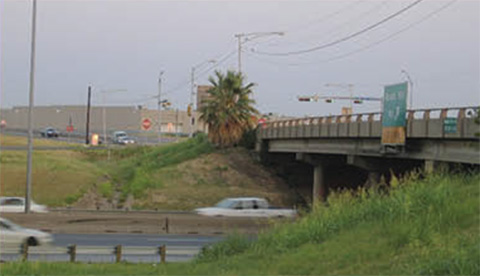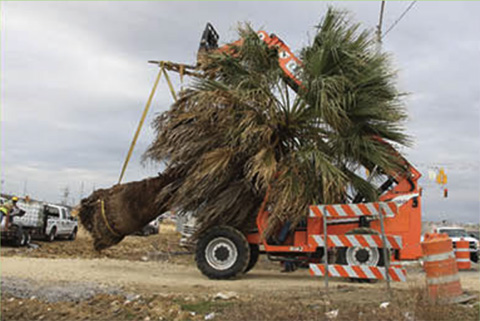
The Highways that Helped Make Arlington America's Mid-City, Part 2 of 3: SH-360 (Angus Wynne Freeway)
The following is an excerpt from Oscar Slotboom's meticulously researched and excellent book (and website) Dallas-Fort Worth Freeways, reprinted here with kind permission from the author. The editor has provided supplemental material to bring the article up-to-date on Arlington's stadiums and amusement facilities.
General Motors announced the acquisition of 255 acres for a potential future manufacturing or assembly operation in August 1951. It wasn't clear at the time if the site was envisioned for an automobile or defense-related operation, but at the groundbreaking ceremony on May 27, 1952, the plant was touted as GM's first dual-purpose plant, designed to be capable of producing military equipment, civilian automobiles, or a combination of both. Plans for aircraft production were abandoned in October 1952 and the plant has been used exclusively for automobile production. The first vehicle, a black Pontiac Chieftan, rolled off the assembly line on January 6, 1954, and the plant was formally dedicated with an open house in June 1954. The plant has survived wave after wave of General Motors plant closings, including the 2009 bankruptcy, and in 2024 produces GM's largest sport utility vehicles.
The General Motors plant site selection was influenced by the need to be on a raiload corridor and at the time the eastern boundary of the plant property was Watson School Road. In 1955 the new regional freeway plan proposed to convert Watson School Road into a freeway with a northward extension across the Trinity River to SH 183 and the new Amon Carter Field airport. There was little progress toward actual construction of the freeway in the following ten years, but the designation of the site of DFW Airport in 1965 revived planning for the freeway
In 1997 SH 360 was named for Angus G. Wynne Jr, a real estate developer who conceived and built Six Flags Over Texas, which opened in August 1961. Prior to Six Flags, Wynne developed the Wynnewood residential development in Dallas' South Oak Cliff, which broke ground in February 1946, and its highly successful Wynnewood Village Shopping Center which first opened in December 1949. Wynne also developed the Great Southwest Industrial District in the area around SH 360 and Interstate 30. Wynne (1914-1979) came from a prominent family originally from Kaufman County, just southeast of Dallas County. In 2024, however, the freeway is rarely referred to as the Wynne Freeway.
In 1966 TxDOT officially designated SH 360 as a freeway from SH 183 to US 287 in Mansfield, and in 1969 the north section from SH 183 to SH 121 in Grapevine received freeway status. In 1967 political leaders unveiled a plan for a network of freeways to serve the planned Dallas-Fort Worth International Airport by its scheduled opening in 1972 (which was delayed to January 1974), including construction of SH 360 between SH 183 and IH 20. But other freeways serving DFW Airport were designated as higher priority, and progress on SH 360 remained slow with no main lanes open or under construction in January 1974 when the airport began operations. Efforts to begin construction were complicated by the 1973 energy crisis and rampant inflation. The first contract for main lanes was scheduled to be awarded in December 1973, but all contract bidding was canceled due to uncertainties over future supplies of fuel and construction material. The project went to bid in January 1974, and the lowest bid was 37% above the estimate. Still, the project moved forward and the first main lanes opened in 1976. Over the next eleven years sections opened to complete the originally planned freeway between SH 183 and IH 20 in 1987.

In 1984 Arlington and Grand Prairie political leaders began efforts to build SH 360 south of IH 20. However, TxDOT's lack of funds made competition for project funding intense and local governments were expected to make increasingly large contributions. In August 1984 TxDOT agreed to build the freeway if most of the right-of-way was donated, and officials in nearby cities began efforts to secure the land, estimated to cost $18 million, with Arlington and Grand Prairie taking the lead. But obtaining land donations proved to be more difficult than expected. When other freeways received large donations of land it was typically by a few wealthy landowners or developers who owned very large tracts in the freeway corridor and would benefit from the freeway. However, the path of SH 360 south of IH 20 generally had a large number of landowners with small tracts of property, and the corridor was not a short-term high-growth area. In July 1986, with a deadline rapidly approaching, Arlington and Grand Prairie disbanded efforts to secure right-of-way donations due to lack of success. The project appeared dead.
But all was not lost. Local officials managed to secure some land donations and the projected traffic on the corridor was revised upward due to the opening of Joe Pool Lake, improving the cost-effectiveness of the project and making it viable. In November 1986 TxDOT approved funding for construction of frontage roads. The first section of frontage roads opened in 1994 and they were completed to US 287 in 2003. A short section of main lanes was completed near IH 20 in 2006, but the remaining 9.7 miles of frontage roads would be tolled. In January 2013 TxDOT and the NTTA reached an agreement for construction of the tolled main lanes, with construction expected between 2015 and 2017.
The northern section of SH 360, along the west side of DFW Airport between SH 183 and SH 121, was also a long-delayed project. After approval by TxDOT in 1969 and a public hearing in 1972, little progress was made until 1984 when TxDOT approved funds for right-of-way acquisition. Construction of the frontage roads moved forward in the early 1990s. On December 18, 1991, the construction zone at the Mid Cities Boulevard overpass served as the backdrop for President George H. W. Bush and a delegation of political leaders as Bush signed the $151 billion Intermodal Surface Transportation Efficiency Act of 1991 (ISTEA), financing highway and mass transit construction for the following six years. The frontage roads were completed in 1992 and the main lanes in 2006.
The Heartwarming Story of the Division Street Palm
It was a very peculiar and unusual instance of freeway landscaping—a palm tree growing and thriving on the embankment of the Division Street overpass. Palm trees in North Texas, along a freeway?

It was certainly not the most hospitable spot for a palm tree with its poor soil, North Texas winters and exhaust-laden air. The tree was a specimen of Washingtonia filifera, commonly called the California Fan Palm, native to spring-fed oases in the desert southwest, primarily in southern California. But this palm tree knew how to survive and grow, becoming a large and prominent tree alongside the roadway. The palm tree was certainly the gem of an otherwise harsh landscape of concrete and nearby industrial structures, including the adjacent General Motors Assembly Plant.

How did the palm tree take root alongside the freeway? Several family members of a former Arlington resident reported a well-established family story (not independently verified) that in 1995 their relative, a musician from Mexico no longer in Texas, was cycling across the Division Street bridge when he saw a nursery-size palm fall from a truck into the roadway. With no way to carry it, he scrabbled a hole next to the road and planted the little tree on the spot.
Richard McMullen, a research engineer, took notice of the tree while driving on SH 360 one day. Fascinated by it, he adopted it as his own and called it the Division Street Palm, keeping watch over it and informing others of its remarkable story. But in 2009 it appeared that the hardy palm tree would meet its end as work was underway on reconstruction and expansion of SH 360, necessitating the removal of the tree. McMullen resolved to do whatever he could to save the tree.

He contacted a Dallas Morning News columnist who featured the story of the tree in the paper in October 2009. Once the story was out, the tree had a future. TxDOT provided equipment and logistical support for the tree removal and a local tree contractor donated labor and transport for the relocation. The chosen destination was a city recreation center near McMullen's home in Carrollton. In December 2009 the Division Street Palm was relocated to its new home where it has been doing well.
The southernmost segment of SH 360 between US 287 in Mansfield and Camp Wisdom Road/Sublett Road in Grand Prairie was built between 1994 and 2003 as a pair of separated frontage roads, with space reserved between them for main freeway lanes to be added to meet future traffic needs. As traffic along the corridor grew, the SH 360 frontage lanes became increasingly congested. Local and state leaders began studying the construction of SH 360 as a freeway between the existing frontage roads in a project that became known as "360 South". On January 25, 2013, TxDOT and the NTTA approved a deal to construct the extension as a four-lane toll road, the 360 Tollway, in a public–public partnership, with TxDOT performing the design and construction and the NTTA managing the completed freeway as part of its tollway system. Construction on the tollway began in November 2015. A ceremonial groundbreaking for construction of the 360 South toll road was held on October 21, 2015. The first phase of the project, which was planned to build two grade-separated toll lanes in each direction, was estimated to cost $330 million. The tollway opened to drivers on May 11, 2018, and became NTTA's newest toll road. In the future, the toll road may be expanded to four lanes in each direction. The 9.7-mile toll road has two names: the portion between US 287 and the Mansfield city limit is named the Senator Chris Harris Memorial Highway after the local legislator who aided the extension, and the portion from the Mansfield city limit to Camp Wisdom/Sublett Road is named the Rosa Parks Memorial Highway in memory of the late civil rights figure. The project cost a total of $340 million. Driving the entire length of the tollway currently costs $1.62 for TollTag users and $2.44 for nonusers, with drivers being billed via mail.
I-30 Interchange Rebuild
The former trumpet interchange between SH 360 and I-30 in Arlington became a major bottleneck, compounded by the fact that it intersected with surface streets and was located near major tourist attractions, including Six Flags Over Texas, Globe Life Field, Choctaw Stadium, and AT&T Stadium. In November 2014, TxDOT announced that it would conduct an environmental study on a potential $200 million rebuild of the interchange. The rebuild would offer direct connections between SH 360 and I-30 for the first time. In March 2015, TxDOT approved spending $254 million on the stack interchange project, which would also include improvements to nearby Six Flags Drive. Ground broke on March 2, 2016, and was estimated to be completed in fall 2020 for $233 million. Construction was completed on December 21, 2023, with the interchange being open to traffic in all directions.
Future Plans
The NTTA's future plans for SH 360 include another 5.5 mile extension of the toll road, which would run from the current SH 360 southern terminus in Mansfield to US 67 in Venus.
...to be continued.
